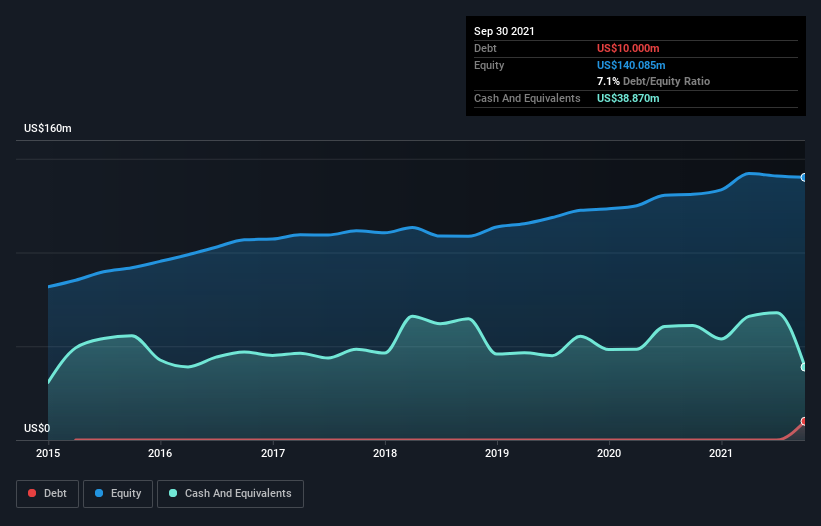Surmodics (NASDAQ:SRDX) Could Easily Take On More Debt
Warren Buffett famously said, 'Volatility is far from synonymous with risk.' So it might be obvious that you need to consider debt, when you think about how risky any given stock is, because too much debt can sink a company. Importantly, Surmodics, Inc. (NASDAQ:SRDX) does carry debt. But is this debt a concern to shareholders?
When Is Debt Dangerous?
Debt and other liabilities become risky for a business when it cannot easily fulfill those obligations, either with free cash flow or by raising capital at an attractive price. In the worst case scenario, a company can go bankrupt if it cannot pay its creditors. However, a more common (but still painful) scenario is that it has to raise new equity capital at a low price, thus permanently diluting shareholders. Having said that, the most common situation is where a company manages its debt reasonably well - and to its own advantage. The first thing to do when considering how much debt a business uses is to look at its cash and debt together.
View our latest analysis for Surmodics
What Is Surmodics's Net Debt?
You can click the graphic below for the historical numbers, but it shows that as of September 2021 Surmodics had US$10.0m of debt, an increase on none, over one year. But on the other hand it also has US$38.9m in cash, leading to a US$28.9m net cash position.
How Healthy Is Surmodics' Balance Sheet?
Zooming in on the latest balance sheet data, we can see that Surmodics had liabilities of US$29.8m due within 12 months and liabilities of US$24.7m due beyond that. Offsetting this, it had US$38.9m in cash and US$22.9m in receivables that were due within 12 months. So it actually has US$7.28m more liquid assets than total liabilities.
This state of affairs indicates that Surmodics' balance sheet looks quite solid, as its total liabilities are just about equal to its liquid assets. So while it's hard to imagine that the US$679.8m company is struggling for cash, we still think it's worth monitoring its balance sheet. Simply put, the fact that Surmodics has more cash than debt is arguably a good indication that it can manage its debt safely.
Although Surmodics made a loss at the EBIT level, last year, it was also good to see that it generated US$4.2m in EBIT over the last twelve months. When analysing debt levels, the balance sheet is the obvious place to start. But ultimately the future profitability of the business will decide if Surmodics can strengthen its balance sheet over time. So if you're focused on the future you can check out this free report showing analyst profit forecasts.
But our final consideration is also important, because a company cannot pay debt with paper profits; it needs cold hard cash. Surmodics may have net cash on the balance sheet, but it is still interesting to look at how well the business converts its earnings before interest and tax (EBIT) to free cash flow, because that will influence both its need for, and its capacity to manage debt. Happily for any shareholders, Surmodics actually produced more free cash flow than EBIT over the last year. That sort of strong cash generation warms our hearts like a puppy in a bumblebee suit.
Summing up
While it is always sensible to investigate a company's debt, in this case Surmodics has US$28.9m in net cash and a decent-looking balance sheet. The cherry on top was that in converted 219% of that EBIT to free cash flow, bringing in US$9.1m. So is Surmodics's debt a risk? It doesn't seem so to us. There's no doubt that we learn most about debt from the balance sheet. But ultimately, every company can contain risks that exist outside of the balance sheet. Case in point: We've spotted 4 warning signs for Surmodics you should be aware of, and 1 of them is potentially serious.
If, after all that, you're more interested in a fast growing company with a rock-solid balance sheet, then check out our list of net cash growth stocks without delay.
Have feedback on this article? Concerned about the content? Get in touch with us directly. Alternatively, email editorial-team (at) simplywallst.com.
This article by Simply Wall St is general in nature. We provide commentary based on historical data and analyst forecasts only using an unbiased methodology and our articles are not intended to be financial advice. It does not constitute a recommendation to buy or sell any stock, and does not take account of your objectives, or your financial situation. We aim to bring you long-term focused analysis driven by fundamental data. Note that our analysis may not factor in the latest price-sensitive company announcements or qualitative material. Simply Wall St has no position in any stocks mentioned.

 Yahoo Lifestyle
Yahoo Lifestyle 

